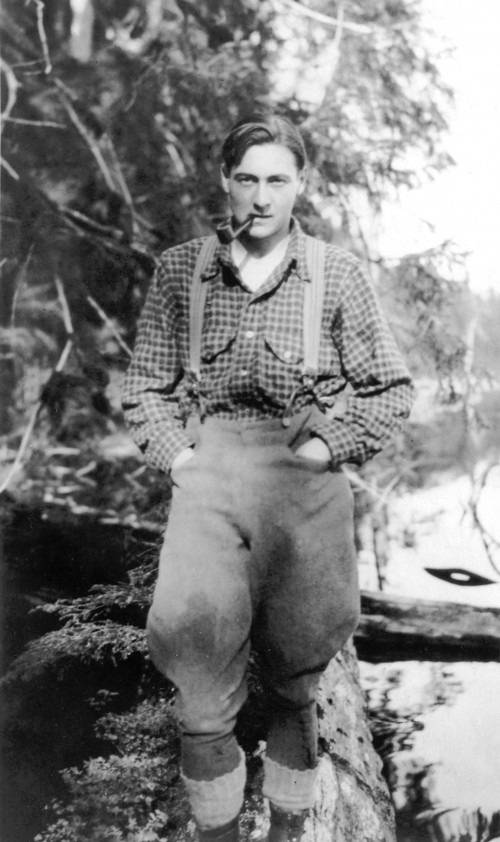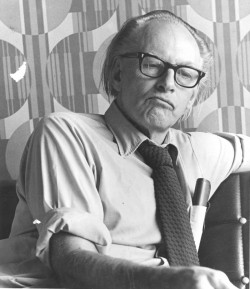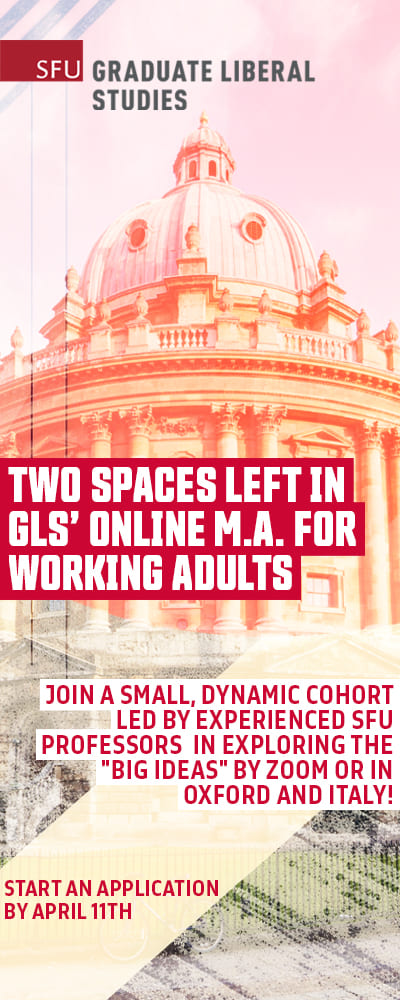#22 Haig-Brown & Al Purdy
“I want to catch some kind of Haig-Brown essence with the halo slightly askew.” — Al Purdy, 1974
by Ron Dart
Al Purdy was one of Canada’s most prolific poets and writers, but when his many published books are listed, one volume, Cougar Hunter: A Memoir of Roderick Haig-Brown, is often omitted.
Cougar Hunter has a controversial history, and the fact that many of the few missives printed were destroyed means that the book is a rare one, indeed.
Robert Cave, in his exceptional book on Haig-Brown, Roderick Haig-Brown: A Descriptive Bibliography (2000), rightly so suggests there is a “Byzantine-like atmosphere that continues to envelop Cougar Hunter” (p.300).
Indeed, it is this Byzantine-like atmosphere that pervades the publication of Cougar Hunter that makes it a collector’s item of sorts. The thin book published in 1992 has sold for about $300 for those who are interested in owning a copy.
In this gem of a Purdy classic, much is learned about Roderick Haig-Brown and Al Purdy. Here is the gist of the story,
*

Al Purdy met the legendary West Coast conservationist, Roderick Haig-Brown, in 1974, at the equally mythical Strathcona Lodge on Vancouver Island. Purdy was at the Lodge to do an essay on “Jack Jackovitch, painter, ex-football player, fishing guide and high school teacher.” Weekend Magazine was going to publish the article. Purdy was 56 at the time (and an established Canadian poet) and Haig-Brown was 66 years of age.
Strathcona Lodge was a meeting/training place for a new and emerging generation of conservationists and preservationists. The Lodge was run by Jim/Myrna Boulding, and the Bouldings had consciously built the Lodge to be an educational centre for ecological awareness and wilderness thinking. Roderick Haig-Brown was, in many ways, the elder of the emerging post-WW II conservationist heritage (and a much respected writer), and Jim/Myrna Boulding and Strathcona Lodge were carrying the Haig-Brown vision a step further.
Haig-Brown had a history of logging, prizefighting, trapping, bounty hunting, farming, writing and holding the positon of magistrate. Such a complex and varied history quite appealed to Purdy and there were some significant affinities between Purdy and Haig-Brown in the way they had lived in their 20s-30s.
There is a definite and defined line and lineage, a passing of the ecological torch from Roderick/Ann Haig-Brown to Jim/Myrna Boulding at Strathcona Lodge to Marlene Smith-Schalkwijk. Marlene has told such a tale well in Changing of the Guards or The Birth of the Friends of Strathcona Park. The more in-depth read and history of Strathcona Lodge has been evocatively told in Myrna Boulding’s Survival Strathcona Style (2009) and the final couple of chapters in Rob Wood’s Towards the Unknown Mountains: An Autobiography from the Canadian Wilderness Frontier (1991).
When Al Purdy met Roderick Haig-Brown at Strathcona Lodge in 1974, he encountered, unbeknownst to him, Roderick in his last few years and the waxing years of Jim/Myrna Boulding and Strathcona Lodge. Purdy could not have appeared at a more opportune time or season–all the main actors and actresses in the ecological ethos were still active and in the thick of the battle for Strathcona Park. Cougar Hunter: A Memoir of Roderick Haig-Brown shuttles the reader back and forth in Haig-Brown’s life and writings and offers the attentive a fine tapestry from which to ponder the significance of Haig-Brown’s literary and ecological contributions to both Canada and beyond.
The first section of Cougar Hunter is called “Death of a Friend”, and in this entrée essay to the book, Purdy discussed his initial meeting with Haig-Brown at Strathcona Lodge, then later at a dinner at the Haig-Brown home in Campbell River with “Jungle Jim”/Myrna Boulding and the Jackovitch couple. The dinner with Roderick/Anne Haig-Brown yet further piqued Purdy’s interest, and he met with Roderick for “two consecutive afternoons”. Purdy was so taken by Haig-Brown that he knew an article was in the offing. He had this to say about the afternoon meetings: “We sat beneath towering walls of books and drank H-B’s booze, good stuff too. And I made notes, a lot of notes. We got along well, and I was acquiring a friend without really being aware of the process.”

Purdy also added about Haig-Brown: “In the beginning I had a feeling of slight unease with him, perhaps because of the propaganda Jack and Jungle Jim had pumped into me.” Despite the early reservations, the friendship between Roderick Haig-Brown and Al Purdy did grow and deepen. The conversations became more relaxed and informal, the content and insights more informed and a delight to read about later on.
“Death of a Friend” comes to a close with Purdy’s comments on Haig-Brown’s obvious horn butting and tensions with J.H. Bloedel (of infamous Island logging fame). Bloedel, upon meeting Haig-Brown said, ‘I hear you’re the worst troublemaker on Vancouver Island’. Cougar Hunter begins with “Death of a Friend”, and Purdy, in a sensitive and tender way, recounts his friendship with Haig-Brown in this essay after Haig-Brown’s unexpected death in 1976.
The second part of Cougar Hunter covers the ongoing correspondence between Purdy and Haig-Brown that began in July 18, 1974 (when Purdy contacted Haig-Brown from Ameliasburgh) and ended, April 29, 1976 (21 letters later), with a letter from Roderick to Purdy from Campbell River. The 21 letters between Al and Rod are worth many a re-read. Each letter, for different reasons, walks the curious into the lives of Purdy and Haig-Brown and the richness of the Canadian literary tradition. The friendship is enriched by the letters and both men tell much about their ongoing lives. Some of the early letters tend to be more preoccupied with Purdy getting the facts of Haig-Brown’s life accurate for his article, but, essay done, broader themes emerge in the correspondence. The exchange of letters between 1974-1976, obviously pre-date “The Death of a Friend” essay, but both complement one another nicely.
The initial reason that Purdy was keen on meeting Haig-Brown in 1974 was Haig-Brown’s fascinating life journey—Purdy sensed a good story in the making. The third part of Cougar Hunter is the essay that Purdy wrote about Haig-Brown for Weekend Magazine—-the article is a hasty biography of Haig-Brown that lights, but does not land long, on some of the high points of Haig-Brown’s full life. This section tells much more about Haig-Brown than does “Death of a Friend”, but both need to be read together—some duplication but fresh perspectives in both beauties. The fact that Cougar Hunter was the first biography of sorts of Haig-Brown makes it a keeper of sorts—Anthony Roberton`s Above Tide: Reflections on Roderick Haig-Brown (1984), Bennet Metcalfe’s The Life of Roderick Langmere Haig-Brown: A Man of Some Importance (1985) and Valerie Haig-Brown`s Deep Currents: Roderick and Ann Haig-Brown (1997) did not come until much later.
Cougar Hunter comes to a fitting and apt close with a poem by Purdy about Haig-Brown: Dear Judge. I have read the poem many times and I’m always taken by the final few lines—quite a tribute to the friendship between Rod and Al.
From where I am now
that place on the other side of the world
is death
and the first stage of friendship is all
that remains of Haig-Brown for me
a few letters
memory of a grin
some beer with him at Campbell River…
Dear Judge Dear Sir Dear Rod H-B
that is not enough
 There are many fine photographs of Haig-Brown in Cougar Hunter that illuminate the landscape of Haig-Brown’s life—obviously, with a title like Cougar Hunter, the reality of cougars (and “Cougar” Smith) factor large in the book. Cougar Hunter was published in a variety of places, including No Other Country (1977) by Purdy and served as the “Introduction” to From the World of Roderick Haig-Brown: Woods and River Tales (1980).
There are many fine photographs of Haig-Brown in Cougar Hunter that illuminate the landscape of Haig-Brown’s life—obviously, with a title like Cougar Hunter, the reality of cougars (and “Cougar” Smith) factor large in the book. Cougar Hunter was published in a variety of places, including No Other Country (1977) by Purdy and served as the “Introduction” to From the World of Roderick Haig-Brown: Woods and River Tales (1980).
There is a definite need to bring to the fore again Cougar Hunter: A Memoir of Roderick Haig-Brown—the exquisite blending of “Death of a Friend”, “Correspondence”, “Cougar Hunter” and “Dear Judge” makes this book a must-have keeper for those with an interest and commitment to the Canadian literary tradition, Roderick Haig-Brown and Al Purdy—-our understanding of Canadian literature, Rod and Al will be weaker, thinner and leaner without Cougar Hunter front and centre in our literary quest for a literature for and of the Canadian people.
[The quote: “I want to catch some kind of Haig-Brown essence with the halo slightly askew.” — Al Purdy is from a letter written by Al Purdy to Roderick Haig-Brown on July 30, 1974.]
—

Ron Dart of Abbotsford has taught in the department of political science/philosophy/religious studies at University of the Fraser Valley since 1990, undertaken Ph.D studies at McMaster University and served on staff with Amnesty International in the 1980s in B.C. He is a leading authority on the subject of Canadian High–Red Toryism, and some of its most significant thinkers, including Stephen Leacock and George Grant. His 25th book The North American High Tory Tradition (American Anglican Press, 2016) has a foreword from Jonathan M. Paquette of the University of St Andrews Institute of Intellectual History. It was celebrated with a public event sponsored by American Anglican Press and the George Grant Society.
Date Of Birth: October 24 1950
Place Of Birth: Toronto
Arrival in Canada:
Arrival in BC: Spring 1979
Education: BA (Lethbridge); DCS, MCS (Regent College), MA (UBC)
BOOKS:
The North American High Tory Tradition (American Anglican Press, 2016) $55
978-0-9963248-3-0
Keepers of the Flame: Canadian Red Toryism (Fermentation Press, 2012)
George P. Grant: Canada’s Lone Wolf: Essays in Political Philosophy (Freshwind Press, 2011)
George Grant: Spiders and Bees (Freshwind Press, 2008)
Thomas Merton and the Beats of the North Cascades (Serratus Press, 2008)
The Eagle and the Ox: Contemplation, the Church and Politics (Freshwind Press, 2007)
Mountaineering and the Humanities (Serratus Press, 2006)
Athens and Jerusalem: George Grant’s Theology, Philosophy, and Politics: co-editor (University of Toronto Press, 2006)
The Beatitudes: When Mountain Meets Valley (Freshwind Press, 2006)
Stephen Leacock: Canada’s Red Tory Prophet (Synaxis Press, 2006)
The Spirituality of John Cassian (Synaxis Press, 2005)
Erasmus and Merton: Soul Friends (Chelsea Press, 2005)
The Canadian High Tory Tradition: Raids on the Unspeakable (Synaxis Press, 2004)
Busking (Synaxis Press, 2003)
Robin Mathews: Crown Prince of Canadian Political Poets (Synaxis Press, 2002)
St. Matthew’s Parish: A People’s History, editor (2001)
Crosshairs: Being Poetic, Being Political, Being Canadian (Synaxis Press, 2000)
The Red Tory Tradition: Ancient Roots, New Routes (Synaxis Press, 1999)
In A Pluralist World (Regent College Publishing, 1998)
The Marks of the Church and Renewal (Chelsea Press, 1994)
Lizard in the Palace (Chelsea Press, 1992)
The Lute and the Anvil (Chelsea Press, 1988)
Contemplation and the Polis (Chelsea Press, 1987)
Adam: Romantics, Rationalists, Prophets: A Dialogue (Chelsea Press, 1985)































4 comments on “#22 Haig-Brown & Al Purdy”
Comments are closed.